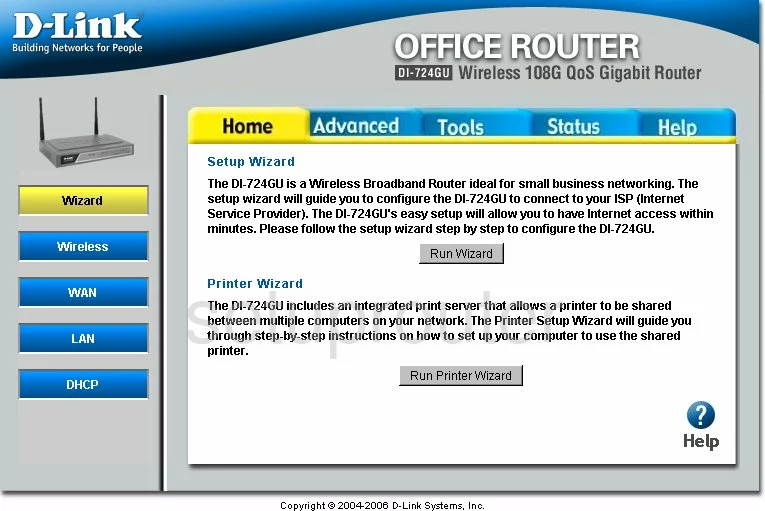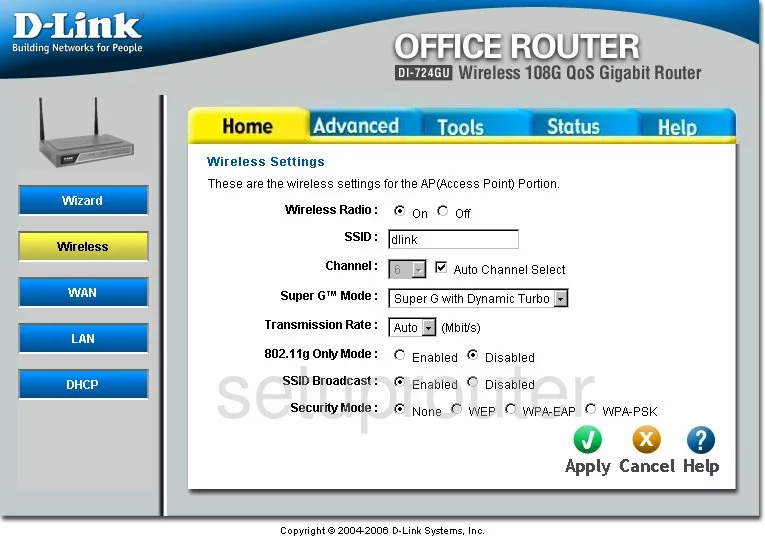The Dlink DI-724GU router is considered a wireless router because it offers WiFi connectivity. WiFi, or simply wireless, allows you to connect various devices to your router, such as wireless printers, smart televisions, and WiFi enabled smartphones.
Other Dlink DI-724GU Guides
This is the wifi guide for the Dlink DI-724GU. We also have the following guides for the same router:
- Dlink DI-724GU - How to change the IP Address on a Dlink DI-724GU router
- Dlink DI-724GU - Dlink DI-724GU Login Instructions
- Dlink DI-724GU - Dlink DI-724GU User Manual
- Dlink DI-724GU - Dlink DI-724GU Port Forwarding Instructions
- Dlink DI-724GU - How to change the DNS settings on a Dlink DI-724GU router
- Dlink DI-724GU - How to Reset the Dlink DI-724GU
- Dlink DI-724GU - Information About the Dlink DI-724GU Router
- Dlink DI-724GU - Dlink DI-724GU Screenshots
WiFi Terms
Before we get started there is a little bit of background info that you should be familiar with.
Wireless Name
Your wireless network needs to have a name to uniquely identify it from other wireless networks. If you are not sure what this means we have a guide explaining what a wireless name is that you can read for more information.
Wireless Password
An important part of securing your wireless network is choosing a strong password.
Wireless Channel
Picking a WiFi channel is not always a simple task. Be sure to read about WiFi channels before making the choice.
Encryption
You should almost definitely pick WPA2 for your networks encryption. If you are unsure, be sure to read our WEP vs WPA guide first.
Login To The Dlink DI-724GU
To get started configuring the Dlink DI-724GU WiFi settings you need to login to your router. If you are already logged in you can skip this step.
To login to the Dlink DI-724GU, follow our Dlink DI-724GU Login Guide.
Find the WiFi Settings on the Dlink DI-724GU
If you followed our login guide above then you should see this screen.

You begin on the Home page of the Dlink DI-724GU router. To configure the WiFi settings, click the blue button on the left side of the page labeled Wireless.
Change the WiFi Settings on the Dlink DI-724GU

On this new page, the first thing you need to do is change the SSID. This is the name you give your wireless network so you can distinguish it from your neighbors wireless networks. Be creative when coming up with a name but don't use personal information. To learn more about this topic, read our Wireless Names Guide.
Now take a look at the Channel. If you want to set to the channel you want, you will have to uncheck the box labeled Auto Channel Select. Then change the channel to the channel you want. The most you can get out of the spectrum without overlap is three. Everyone should be using one of these three channels, 1,6, or 11, to avoid interference from neighboring networks. To learn more about this topic, read our WiFi Channels Guide.
Next, skip down to the Security Mode. There are several choices here, and if you want to learn about them, read our WEP vs. WPA Guide. Our recommendation is WPA-PSK.
You should now have a new section appear labeled WPA. In this section, the first option is WPA Mode. The router is asking you to narrow down you choice. We recommend picking WPA2 Only.
The Cipher Type or encryption method can be set to AES. This form of encryption is considered the most secure with today's technology.
Next is the Passphrase. This is the password you use to gain access to your network. This password you create should be strong, it also is used in the encryption method. Create a password of 14-20 characters than include letters, numbers, and symbols. To learn more about this, read our Choosing a Strong Password Guide.
Re-enter your password in the box labeled Confirm Passphrase.
That's all there is to it, just click the Apply button and you are done.
Possible Problems when Changing your WiFi Settings
After making these changes to your router you will almost definitely have to reconnect any previously connected devices. This is usually done at the device itself and not at your computer.
Other Dlink DI-724GU Info
Don't forget about our other Dlink DI-724GU info that you might be interested in.
This is the wifi guide for the Dlink DI-724GU. We also have the following guides for the same router:
- Dlink DI-724GU - How to change the IP Address on a Dlink DI-724GU router
- Dlink DI-724GU - Dlink DI-724GU Login Instructions
- Dlink DI-724GU - Dlink DI-724GU User Manual
- Dlink DI-724GU - Dlink DI-724GU Port Forwarding Instructions
- Dlink DI-724GU - How to change the DNS settings on a Dlink DI-724GU router
- Dlink DI-724GU - How to Reset the Dlink DI-724GU
- Dlink DI-724GU - Information About the Dlink DI-724GU Router
- Dlink DI-724GU - Dlink DI-724GU Screenshots